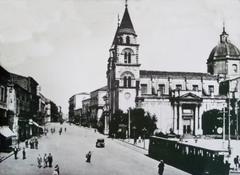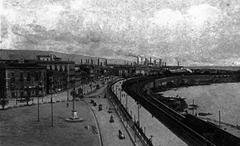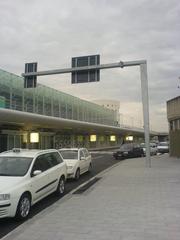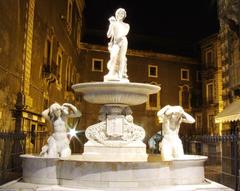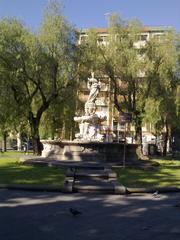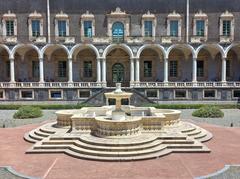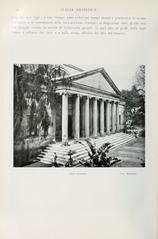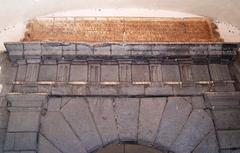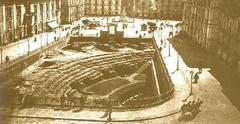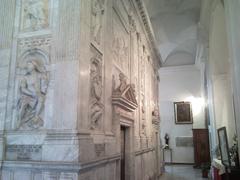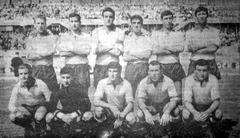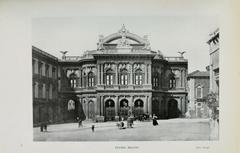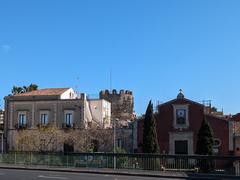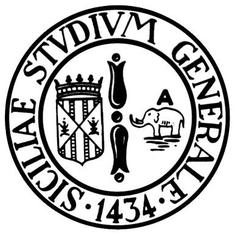Antiquarium Regionale Al Teatro Romano Catania: Visiting Hours, Tickets, and Historical Significance
Date: 04/07/2025
Introduction
Situated in the heart of Catania’s historic center, the Antiquarium Regionale Al Teatro Romano offers a compelling journey through Sicily’s ancient and more recent past. Adjacent to the evocative ruins of the Roman Theatre, the museum is housed within the historic Casa Pandolfo and Casa Liberti, both of which blend seamlessly into the archaeological fabric of the city. The Antiquarium’s collections, featuring artifacts from prehistoric times through the Baroque era, illuminate the city’s continuous evolution and enduring cultural identity. This guide provides comprehensive information on visiting hours, ticketing, accessibility, and practical tips to maximize your experience, making it indispensable for history enthusiasts and cultural travelers alike.
For the most up-to-date information, visitors are encouraged to consult official sources such as the Parco Archeologico e Paesaggistico di Catania e della Valle dell’Aci and dedicated museum platforms (whichmuseum.fr).
Table of Contents
- Introduction
- Origins and Historical Development
- Archaeological Discoveries and Museum Collections
- Visiting Information: Hours, Tickets, and Accessibility
- Travel Tips and Nearby Attractions
- Frequently Asked Questions (FAQ)
- Conclusion
- References
Origins and Historical Development
Greek and Prehistoric Roots
The site of the Teatro Romano and Antiquarium Regionale is linked to Catania’s earliest human activity. Archaeological evidence points to settlements on Montevergine, the city’s ancient acropolis, dating back to prehistoric times. During the Greek era, the area hosted a sanctuary dedicated to Demeter and Kore, underscoring its importance as a religious and civic center (parchiarcheologici.regione.sicilia.it).
Roman Expansion and Urban Role
The Roman Theatre, built in the 1st century CE and expanded in the 2nd century, became a pivotal venue for public entertainment. Its semicircular cavea, constructed with local lava stone and marble, could accommodate thousands of spectators. The adjacent Odeon, a smaller structure, was used for music, poetry, and rehearsals, reflecting the rich cultural life of Roman Catania. Both structures were adapted over the centuries, hosting aquatic spectacles before eventually falling into disuse (parchiarcheologici.regione.sicilia.it).
Medieval and Baroque Transformations
Following the Roman period, the theater and surrounding area underwent significant changes. The site was repurposed for various uses, including as a slaughterhouse and residential buildings. Medieval and Baroque structures were built over the ancient remains, which were later revealed through archaeological excavations. This layering is still visible today, providing a tangible record of Catania’s resilience and adaptability.
Archaeological Discoveries and Museum Collections
The Antiquarium Regionale: Casa Pandolfo & Casa Liberti
The Antiquarium museum, housed in Casa Pandolfo and Casa Liberti, preserves and interprets the site’s archaeological heritage. Visitors can explore:
- Roman-era artifacts: Marble cornices, mosaics, sculptural elements, and everyday ceramics from the 2nd–3rd centuries CE.
- Medieval and Baroque remnants: Architectural fragments, religious statuary, and decorative elements illustrating successive historical periods.
- Archaeological context: Informative panels (primarily in Italian, with some English) provide context for the artifacts and their significance to Catania’s urban development (tmatic.travel, whichmuseum.fr).
Museum Layout and Visitor Flow
The museum’s compact design allows for a focused visit, typically lasting 45–60 minutes. A highlight is the terrace, which offers panoramic views of the Roman Theatre, providing unique photographic opportunities and a deeper appreciation of the site’s integration into the city (whichmuseum.it).
Visiting Information: Hours, Tickets, and Accessibility
Opening Hours
- Summer (April–October): Tuesday–Sunday, 9:00 a.m. – 7:00 p.m. (last entry 6:30 p.m.)
- Winter (November–March): Tuesday–Sunday, 9:00 a.m. – 5:00 p.m. (last entry 4:30 p.m.)
- Closed: Mondays and public holidays (Parco Archeologico)
Always verify current hours on the official website before visiting.
Tickets and Admission
- Standard ticket: €8.00
- Reduced ticket: €4.00 (eligibility varies; often for students, seniors, or groups)
- Free entry: First Sunday of each month
- Includes access to both the Antiquarium and the Roman Theatre and Odeon (whichmuseum.com)
Ticket Booking
Online reservations are recommended to avoid queues, especially during peak times or special events (Parco Archeologico).
Accessibility and Facilities
- The museum is partially accessible; some areas may be difficult to reach due to the historic architecture. Entrances at Via Vittorio Emanuele, 270 and Via Teatro Greco, 7 are equipped for visitors with disabilities, but advance notice is advised (parchiarcheologici.regione.sicilia.it, whichmuseum.fr).
- On-site amenities such as restrooms or cafés are limited; plan to use facilities in the nearby city center.
Travel Tips and Nearby Attractions
Practical Tips
- When to visit: Weekday mornings or late afternoons are best for avoiding crowds. The first Sunday of the month is free but can be busier.
- Duration: Allow 1–1.5 hours for a comprehensive visit.
- Footwear: Wear comfortable shoes due to uneven surfaces and stairs.
- Photography: The terrace provides excellent views; photography is generally permitted, but tripods/flash may be restricted—check local signage.
Nearby Attractions
- Benedictine Monastery of San Nicolò l’Arena
- Museo Civico Castello Ursino
- Museo Vincenzo Bellini
- Catania Fish Market
- Piazza del Duomo
All are within walking distance, making the Antiquarium an ideal starting point for exploring Catania’s historical landscape (Travelling Jezebel, The Crazy Tourist).
Frequently Asked Questions (FAQ)
Q: What are the Antiquarium Regionale Al Teatro Romano visiting hours?
A: Summer: Tuesday–Sunday, 9:00 a.m.–7:00 p.m. (last entry 6:30 p.m.); Winter: Tuesday–Sunday, 9:00 a.m.–5:00 p.m. (last entry 4:30 p.m.); closed Mondays.
Q: How much are tickets?
A: Standard €8.00; reduced €4.00; free on the first Sunday of each month.
Q: Is the museum accessible to visitors with disabilities?
A: Partially. Some historic areas may present challenges; contact the museum in advance for assistance.
Q: Are guided tours available?
A: The museum does not regularly offer guided tours, but local operators provide walking tours that include the site. Booking ahead is advisable.
Q: Can I take photos inside the museum?
A: Photography is typically permitted, but always check at the entrance for current policy.
Conclusion
The Antiquarium Regionale Al Teatro Romano, together with the Roman Theatre, stands as a testament to Catania’s layered history and vibrant cultural identity. With its accessible central location, well-curated exhibits, and panoramic terrace, the museum offers an enriching experience for visitors. Thoughtful planning—checking opening hours, ticketing options, and accessibility—ensures a rewarding visit. Combine your tour with other nearby attractions to fully immerse yourself in Catania’s multifaceted heritage.
For updates on hours, ticketing, and special events, consult the official website or trusted museum platforms.
References
- Parco Archeologico e Paesaggistico di Catania e della Valle dell’Aci
- whichmuseum.fr
- tmatic.travel
- The Crazy Tourist
- Travelling Jezebel
- Museionline
- Wikipedia
For the most current visitor information, always refer to official sources and museum directories.
